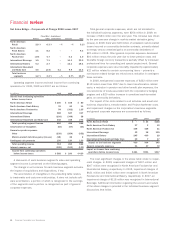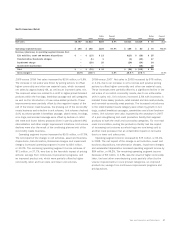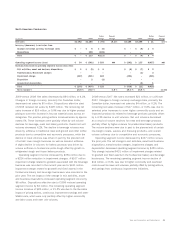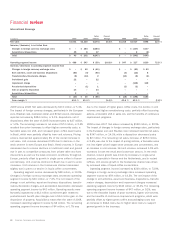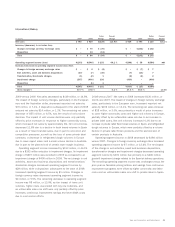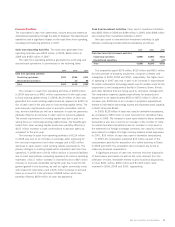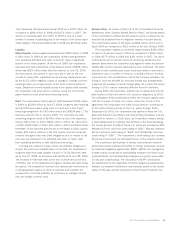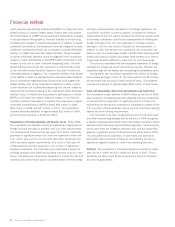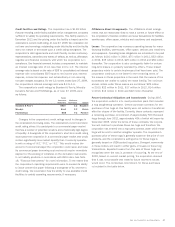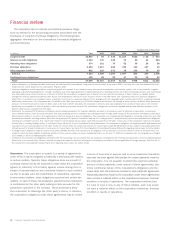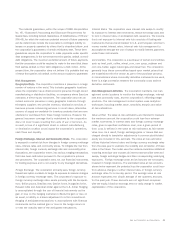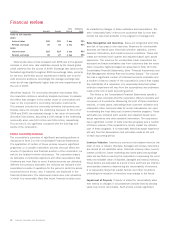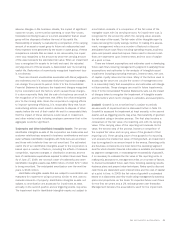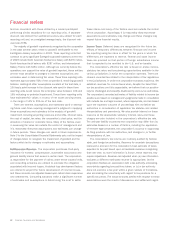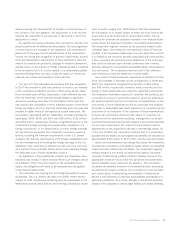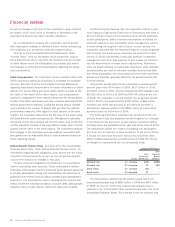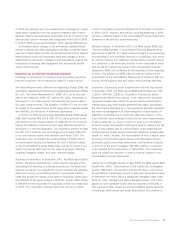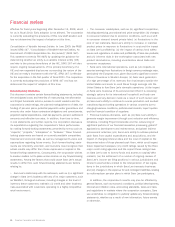Sara Lee 2009 Annual Report Download - page 38
Download and view the complete annual report
Please find page 38 of the 2009 Sara Lee annual report below. You can navigate through the pages in the report by either clicking on the pages listed below, or by using the keyword search tool below to find specific information within the annual report.Financial review
36 Sara Lee Corporation and Subsidiaries
which requires substantially underfunded MEPPs to implement reha-
bilitation plans to improve funded status. Factors that could impact
the funded status of a MEPP include investment performance, changes
in the participant demographics, financial stability of contributing
employers and changes in actuarial assumptions. In addition to regular
scheduled contributions, the corporation could be obligated to make
additional contributions (known as a complete or partial withdrawal
liability) if a MEPP has unfunded vested benefits. These complete
or partial withdrawal liabilities would be triggered if the corporation
ceases to make contributions to that MEPP, either completely or with
respect to only one or more collective bargaining units. The with-
drawal liability would equal the corporation’s proportionate share
of the unfunded vested benefits, based on the year in which the
withdrawal liability is triggered. The corporation believes that certain
of the MEPPs in which we participate have unfunded vested benefits.
Due to uncertainty regarding future factors that could trigger with-
drawal liability, such as the corporation’s decision to close a plant
or the dissolution of a collective bargaining unit, we are unable to
determine the amount and timing of the corporation’s future withdrawal
liability, if any, or whether the corporation’s participation in these
MEPPs could have any material adverse impact on its financial
condition, results of operations or liquidity. The corporation’s regular
scheduled contributions to MEPPs totaled $49 million in 2009,
$48 million in 2008 and $47 million in 2007. The corporation
incurred withdrawal liabilities of approximately $31 million in 2009,
and immaterial amounts in 2008 and 2007.
Repatriation of Foreign Earnings and Income Taxes Since 2006,
the corporation has adopted a policy of repatriating a higher level of
foreign sourced earnings to partially fund U.S. cash requirements.
The Hanesbrands business that was spun off in 2007 historically
generated a significant amount of cash from operations within the
U.S., which was used to service debt payments, dividends and
other domestic capital requirements. As a result of the spin off
of Hanesbrands and the disposition of a number of significant
European operations, the corporation has repatriated a portion of
earnings annually since 2006 and will likely continue to do so in the
future. This policy will increase the corporation’s income tax rate and
increase cash income taxes paid. In its determination of which foreign
earnings are permanently reinvested in its foreign operations, the
corporation considers numerous factors, including the financial
requirements of the U.S. parent company, the financial requirements
of its foreign subsidiaries, and the tax consequences of remitting the
foreign earnings to the U.S. The repatriation of foreign sourced
earnings is not the only source of liquidity for the corporation. In
addition to cash flow derived from operations, the corporation has
access to the commercial paper market, a $1.85 billion revolving credit
facility, and access to public and private debt markets as a means
to generate liquidity sufficient to meet its U.S. cash flow needs.
The tax costs associated with the anticipated repatriation of foreign
earnings are recognized as the amounts are earned. However, the
corporation pays the tax liability upon completing the repatriation action.
During 2009, the corporation repatriated $1.0 billion of foreign
accumulated earnings to the U.S. The taxes paid on the $1.0 billion
dividend were fully accrued in 2009 and prior years. This dividend
required the payment of approximately $160 million of cash taxes.
Cash and Equivalents, Short-Term Investments and Cash Flow
The corporation’s cash balance of $959 million at the end of 2009
was invested in interest-bearing bank deposits that are redeemable
on demand by the corporation. A significant portion of cash and
equivalents are held by the corporation’s subsidiaries outside of the
U.S. A portion of these balances will be used to fund future working
capital and other funding requirements.
The corporation has also recognized amounts for transformation
and other restructuring charges and at the end of 2009 recognized
a liability of approximately $160 million that relates primarily to future
severance and other lease and contractual payments. These amounts
will be paid when the obligation becomes due, and the corporation
expects a significant portion of these amounts will be paid in 2010.
The anticipated 2010 payments of cash taxes and severance
associated with previously recognized exit activities will have a
significant negative impact on cash from operating activities.
Dividend The corporation’s annualized dividend amounts per share
were $0.44 in 2009, $0.42 in 2008 and $0.40 in 2007. Future
dividends are determined by the corporation’s Board of Directors
and are not guaranteed.


